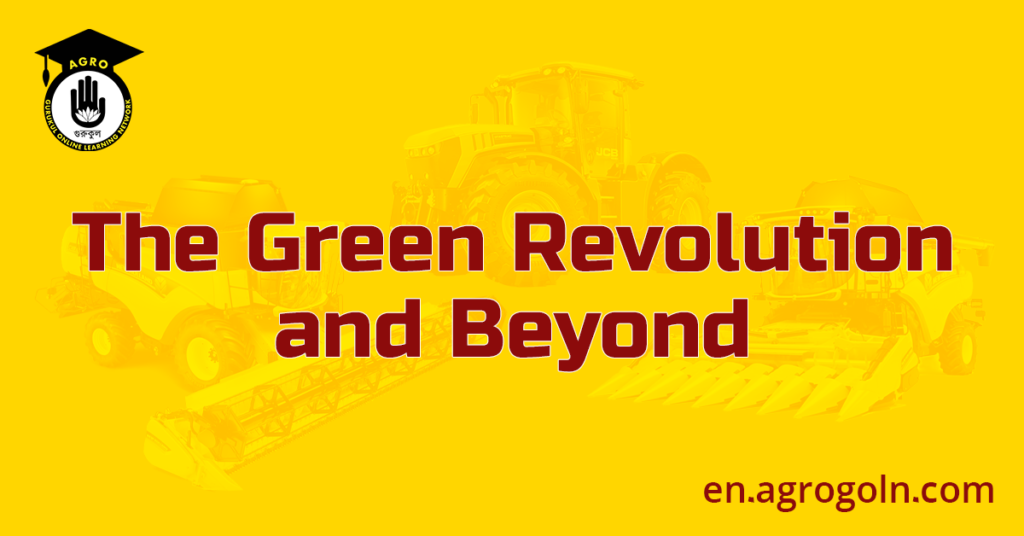The Green Revolution, which began in the mid-20th century, is often hailed as one of the most significant advancements in agriculture. It was a transformative period marked by the widespread adoption of high-yield crop varieties, increased use of fertilizers and pesticides, and modern farming practices. The Green Revolution played a crucial role in increasing food production and alleviating hunger in many parts of the world.
The Green Revolution and Beyond
However, it also brought about environmental and social challenges. As we look beyond the Green Revolution, a new agricultural paradigm is emerging—one that embraces sustainability, resilience, and equitable development. This article explores the history, impact, and challenges of the Green Revolution while exploring the innovative approaches and technologies shaping agriculture’s future.
The Green Revolution: Origins and Impact
The Green Revolution, initiated in the 1940s and 1950s, was primarily focused on developing high-yield crop varieties, particularly wheat and rice. Scientists and agronomists like Norman Borlaug played a central role in breeding these new varieties, which were capable of producing significantly higher yields under optimal conditions. These new crop varieties, combined with the application of fertilizers and pesticides, dramatically increased crop yields in many parts of Asia, Latin America, and Africa.
The impact of the Green Revolution was profound. Crop yields soared, and regions that were once facing food shortages experienced surplus harvests. Countries like India, Mexico, and the Philippines saw significant improvements in food security and reduced dependence on food imports. The Green Revolution was instrumental in preventing widespread famine and lifting millions out of poverty.
Challenges of the Green Revolution
While the Green Revolution brought significant benefits, it also had its share of challenges and negative consequences. Here are some of the main challenges associated with this agricultural transformation:
Environmental Concerns:
The Green Revolution relied heavily on the use of chemical fertilizers and pesticides, which raised environmental concerns. The excessive use of these inputs led to soil degradation, water pollution, and the loss of biodiversity. Moreover, the monoculture cropping practices associated with high-yield varieties contributed to a loss of genetic diversity in crop plants.
Water Scarcity:
High-yield crop varieties required more water to achieve their potential, leading to increased water demand and potential water scarcity issues. In many regions, the over-extraction of groundwater for irrigation has depleted aquifers and led to long-term sustainability challenges.
Social Inequity:
The benefits of the Green Revolution were not equally distributed, leading to social inequities. Large-scale farmers with access to resources and capital were the primary beneficiaries, while small-scale farmers and marginalized communities often faced challenges in accessing the latest technologies and improved seeds.
Dependency on External Inputs:
The Green Revolution’s success was dependent on the regular application of fertilizers, pesticides, and other external inputs. This reliance on external inputs increased the financial burden on farmers and made them vulnerable to fluctuating global commodity prices.
Beyond the Green Revolution: A New Agricultural Paradigm
As the world faces new challenges such as climate change, population growth, and environmental degradation, the need for a more sustainable and resilient agricultural system has become evident. Beyond the Green Revolution, a new paradigm is emerging—one that embraces agroecological principles, technological innovation, and social inclusion. Here are some key aspects of this evolving agricultural paradigm:
Agroecology:
Agroecology is a holistic approach to agriculture that seeks to mimic natural ecosystems and work in harmony with nature. It emphasizes the importance of biodiversity, soil health, and ecosystem services. Practices such as crop rotation, cover cropping, agroforestry, and organic farming are central to agroecology. Agroecological approaches promote resilient, diverse, and sustainable food systems.
Precision Agriculture and Digital Technologies:
Modern technologies, such as precision agriculture and digital farming tools, are transforming agriculture. Precision agriculture uses data analytics, sensors, and satellite imagery to optimize crop management, resource use, and decision-making. These technologies help reduce waste, increase efficiency, and minimize the environmental impact of farming.
Climate-Smart Agriculture:
Climate-smart agriculture aims to address the challenges of climate change while increasing agricultural productivity and resilience. It involves practices like drought-resistant crop varieties, water-efficient irrigation, and climate-adaptive land management. Climate-smart agriculture helps farmers adapt to changing climate conditions and reduce greenhouse gas emissions.
Regenerative Agriculture:
Regenerative agriculture goes beyond sustainability by actively restoring ecosystems and soil health. It focuses on building soil organic matter, increasing biodiversity, and enhancing ecosystem services. Regenerative practices, such as no-till farming, agroforestry, and rotational grazing, promote carbon sequestration and enhance the natural resilience of agroecosystems.
Empowerment and Social Inclusion:
To ensure the success of agricultural transformation, it is essential to empower farmers and promote social inclusion. Supporting small-scale farmers, especially women, with access to resources, knowledge, and markets can enhance agricultural productivity and rural development.
The Green Revolution was undoubtedly a turning point in agricultural history, bringing unprecedented increases in crop yields and alleviating hunger for many people worldwide. However, it also highlighted the limitations of a purely production-driven approach and raised important environmental and social concerns.
As we look beyond the Green Revolution, a new agricultural paradigm is taking shape—one that prioritizes sustainability, resilience, and social inclusion. Agroecological principles, precision agriculture, climate-smart practices, and regenerative approaches are at the forefront of this transformation. Embracing technological innovation, ecological sensitivity, and social equity will be essential in shaping a more sustainable and prosperous future for agriculture and food systems.
While challenges remain, the collective effort of farmers, researchers, policymakers, and consumers will pave the way for a thriving agricultural sector that can meet the needs of a growing global population while safeguarding the planet for generations to come. The journey beyond the Green Revolution holds the promise of a more harmonious and resilient coexistence between agriculture and the natural world.
See more:

